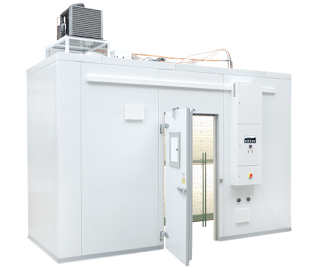 |
| Walk-in Controlled Environment Room Courtesy Percival Scientific |
Lab equipment that provides a temperature control function will often have an integrated heating or cooling means that is regulated by the unit controller. Controlled environment chambers, including benchtop, floor standing, and walk-in types often are provided with sufficient heating of cooling capacity to do damage to the equipment, the contained product or work materials, even surrounding spaces if allowed to run out of control. Why so much power? Designing a chamber of any size to provide fast recovery after a disturbance, like a door opening, will boost the capacity requirements for the heating and cooling portions of the system. Similarly, equipment with extended temperature range is likely to have expanded cooling or heating, and there are many other performance requirements that have the same impact on the unit capacity. The key element for placing this type of equipment in an occupied space is how malfunction resulting in uncontrolled operation of the environmental conditioning system is handled to prevent catastrophe.
An alarm is an annunciation of an adverse condition. Alarm function may be, and often is, provided as part of the temperature controller, utilizing the same device, same sensor. Alarms tell the operator something has gone wrong, is about to go wrong, or is currently going wrong. The nature of most alarms allows the user to set the conditions at which notification occurs. Additionally, some equipment provides options for how alarms are handled. Audio and visual indication are common features, and some equipment is provided with alarm relay contacts that can be connected to building management systems or other remote monitoring equipment. Whether an alarm will automatically reset if proper conditions are restored, or manual intervention is required to stop any alarm related activity once the alarm has occurred can also be different ways in which alarm functions are implemented by manufacturers. The overall range of alarm functionality combinations is extensive, with some equipment providing richer feature sets than others.
Alarms, in some controlled environment systems, are configured to take some sort of action to remediate the adverse condition. This activity is separate from the announcement of the alarm condition. While having corrective action taken by the control system may seem advantageous, and in some cases it may help prevent loss or damage to product contained within the environmental chamber, this is not true limit control action and is not the best practice for assuring safe operation of machinery with the capacity to do real damage to itself or surrounding spaces.
A limit control may appear at the user interface level to mimic the function of an alarm. There is a difference, though. Properly done, a limit control operates with total independence from any part of the regular temperature controller. The limit controller will be a separate device and not share any operating hardware with the temperature controller device chain. What does this mean for the user?
Relying on the temperature controller to respond to an adverse condition has some potential flaws. The temperature controller, or any of the components in the temperature control device chain, could be the root cause of the adverse condition through malfunction or outright failure. Reliance on a control circuit, likely with a malfunction of one or more of its components, to prevent further temperature excursion is not good practice. A properly designed limit control circuit does not rely on any of the components in the potentially failed circuit to stop heating or cooling.
Not all failures are a single event. Chains of failure can trigger, or one failure can expose the existence of another system weakness or failure that was previously undetected. Having a positive and independent means to reliably stop system operation is not costly to implement and can head off catastrophes resulting in substantial loss of time and money. Catastrophe, for an environmental chamber, can look like this...
- Freezing of product that should not be frozen
- Freezing and bursting of pipes in a walk-in chamber
- Destruction of work or product contained within a chamber due to excessively hot or cold temperatures
- Excessively hot temperature that activates a fire protection sprinkler head in walk-in unit
In essence, the purpose of an environmental chamber is to create and maintain a single condition at any point in time. There is only one way that things can go right, and countless ways they can go wrong. Having an independent watchdog controller that prevents the worst from happening is good practice. Share your controlled environment chamber requirements and concerns with an application specialist. The combination of your process knowledge and experience with their product application expertise will yield an effective solution.
that we practice to the conference and SHINE! And SHINE they DID! The support from previous administrators, from our tech facilitator and media coordinators past and present was so appreciated. Penrith CCTV systems
ReplyDelete